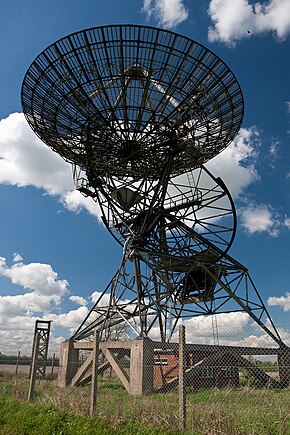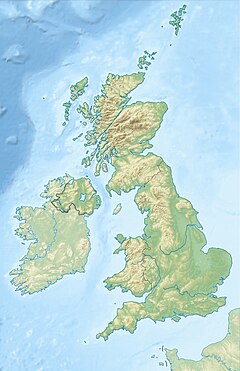Observatory in the United Kingdom
Observatory
West aerial of the One-Mile Telescope at MRAO The Mullard Radio Astronomy Observatory (MRAO ) is located near Cambridge , UK and is home to a number of the largest and most advanced aperture synthesis radio telescopes in the world, including the One-Mile Telescope , 5-km Ryle Telescope , and the Arcminute Microkelvin Imager . It was founded by the University of Cambridge and is part of the Cambridge University, Cavendish Laboratories, Astrophysics Department.
History
Radio interferometry started in the mid-1940s on the outskirts of Cambridge , but with funding from the Science Research Council and a corporate donation of £100,000 from Mullard Limited, a leading commercial manufacturer of thermionic valves .
Construction of the Mullard Radio Astronomy Observatory commenced at Lords Bridge Air Ammunition Park ,[ 1] Cambridge .
The observatory was founded under Martin Ryle of the Radio-Astronomy Group of the Cavendish Laboratory , University of Cambridge and was opened by Sir Edward Victor Appleton on 25 July 1957. This group is now known as the Cavendish Astrophysics Group .
Location
The observatory is located a few miles south-west of Cambridge at Harlton on a former ordnance storage site, next to the disused Oxford-Cambridge Varsity railway line .
A portion of the track bed of the railway, running nearly east-west for several miles, was used to form the main part of the "5km" radio-telescope and the Cambridge Low Frequency Synthesis Telescope . Due to this, the reconstruction of the railway line between Oxford and Cambridge will follow a new alignment at this point.
Telescopes
Gallery
The following photographs (except for the last 2 items) were taken in June 2014:
Platform and Lecture Room formerly part of Lord's Bridge Railway Station
Arcminute Microkelvin Imager - Large Array (AMI-LA)
Arcminute Microkelvin Imager - Small Array (AMI-SA)
Stitched panorama of the Cosmic Anisotropy Telescope enclosure
Part of the Cambridge Optical Aperture Synthesis Telescope
The interior of the bunker of the Cambridge Optical Aperture Synthesis Telescope
The receiver from the e-MERLIN array
Surviving Yagi antennas of the Cambridge Low Frequency Synthesis Telescope
Two Half-Mile Telescopes
Remains of the Interplanetary Scintillation Array
One-Mile Telescope (left), two of the Half-Mile Telescope (centre) and the remains of the 4C Array (right)
Remains of the 4C Array, with One-Mile Telescope in the background
Mullard EL34 Power
Pentode . Mullard produced up to 40% of
thermionic valves used by Britain during 1939-1945 War
Mullard Radio Astronomy Observatory plaque
References
Notes
Sources
Concepts Radio telescopes List )
Individual Interferometers
Allen Telescope Array (ATA, California, US )Atacama Large Millimeter Array (ALMA, Chile )Australia Telescope Compact Array (ATCA, Australia )Australian Square Kilometre Array Pathfinder (ASKAP, Australia )Canadian Hydrogen Intensity Mapping Experiment (CHIME, Canada )Combined Array for Research in Millimeter-wave Astronomy (CARMA, California, US )European VLBI Network (Europe) Event Horizon Telescope (EHT)Giant Metrewave Radio Telescope (GMRT, India )Green Bank Interferometer (GBI, West Virginia, US )Korean VLBI Network (KVN, South Korea )Large Latin American Millimeter Array (LLAMA, Argentina/Brazil )Long Wavelength Array (LWA, New Mexico, US )Low-Frequency Array (LOFAR, Netherlands )MeerKAT (South Africa )Molonglo Observatory Synthesis Telescope (MOST, Australia )Multi-Element Radio Linked Interferometer Network (MERLIN, UK )Murchison Widefield Array (MWA, Australia )Northern Cross Radio Telescope (Italy )Northern Extended Millimeter Array (France )One-Mile Telescope (UK) Primeval Structure Telescope (PaST, China )Square Kilometre Array (SKA, Australia, South Africa )Submillimeter Array (SMA, US )Very Large Array (VLA, New Mexico, US )Very Long Baseline Array (VLBA, US )Westerbork Synthesis Radio Telescope (WSRT, Netherlands ) Space-based
Observatories Multi-use People Astronomy by Related articles















